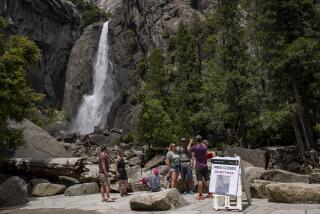Here’s One for Nature
- Share via
When B.J. Griffin, former superintendent of Yosemite National Park, pondered the park’s recovery from last winter’s awesome flood, she commented that “nature unbridled is what we are all about.”
The flood in fact has helped to advance a proposed Yosemite master plan that has been under discussion and study for 20 years. The revised plan unveiled by U.S. Park Service officials Wednesday seeks to provide a more natural Yosemite Valley for visitors by removing many unnecessary structures and cutting peak summer auto traffic by as much as 50%.
Portions of campgrounds and other facilities would be moved back from the Merced River flood plain. More than 140 acres of parking lot and asphalt roads would be returned to a natural state. Lodging facilities would be reduced by 20%. A major increase in hiking and bicycle trails is planned.
The Park Service seeks final adoption of the plan by next summer. Implementation would take 10 years and cost between $140 million and $270 million, depending on which alternative provisions are adopted.
The key to the proposed changes is the decision to keep day visitors from driving their autos into Yosemite Valley, the heart of the park, an enclave roughly a mile wide and five to seven miles long and enclosed by magnificent granite walls soaring 3,500 feet above the river and meadows. Day visitors would leave their autos outside the park and then be taken by bus to a transit station just inside the valley. From there, they would be taken to valley destinations by jitneys or similar vehicles.
This would be an inconvenience for those accustomed to motoring leisurely into the congested valley, gawking at the scenery, parking and getting an ice cream cone or pizza and then driving out. But there is no other rational choice.
The challenge is to develop an efficient transit system. If such a system meets broad public acceptance, it might be possible one day to eliminate all private auto traffic from the valley floor. Then Yosemite would begin to approach Griffin’s concept of “nature unbridled.”
More to Read
Sign up for The Wild
We’ll help you find the best places to hike, bike and run, as well as the perfect silent spots for meditation and yoga.
You may occasionally receive promotional content from the Los Angeles Times.






